
-
- to
Here you will find Viet Nguyen's paper
The use of Atmospheric Pressure Spatial Atomic Layer Deposition (AP-SALD) has gained popularity in the last decade. The success of this technique relies on the possibility to deposit thin films in a fast, vacuum-free, low-cost, low-damage, and high throughput way. In this work, we present ZnO and Aluminium doped ZnO (AZO) films deposited by AP-SALD at low temperature (<220 °C) with high uniformity and conformity. The ZnO films present a high transparency of 80%–90% in the visible range, with a tuneable band-gap, between 3.30 eV and 3.55 eV, controlled by the deposition temperature. The carrier density reaches values greater than 3 × 1019 cm−3, while the electron mobility of the films is as high as 5.5 cm2 V−1 s−1, resulting in an optimum resistivity of 5 × 10−2 Ω cm. By doping ZnO with aluminium, the resistivity decreases down to 5.57 × 10−3 Ω cm, as a result of a significant increase in the carrier density up to 4.25 × 1020 cm−3. The combination of ZnO thin films with p-type cuprous oxide (Cu2O), deposited by aerosol assisted metal organic chemical vapor deposition, allowed the formation of oxide-based pn junctions. The dark I-V characteristic curve confirms a rectifying behaviour, opening the window for the production of all-oxide solar cells completely by chemical vapour deposition methods. We also show the potential of AP-SALD to deposit AZO as a transparent conductive oxide layer for silicon heterojunction solar cells.


